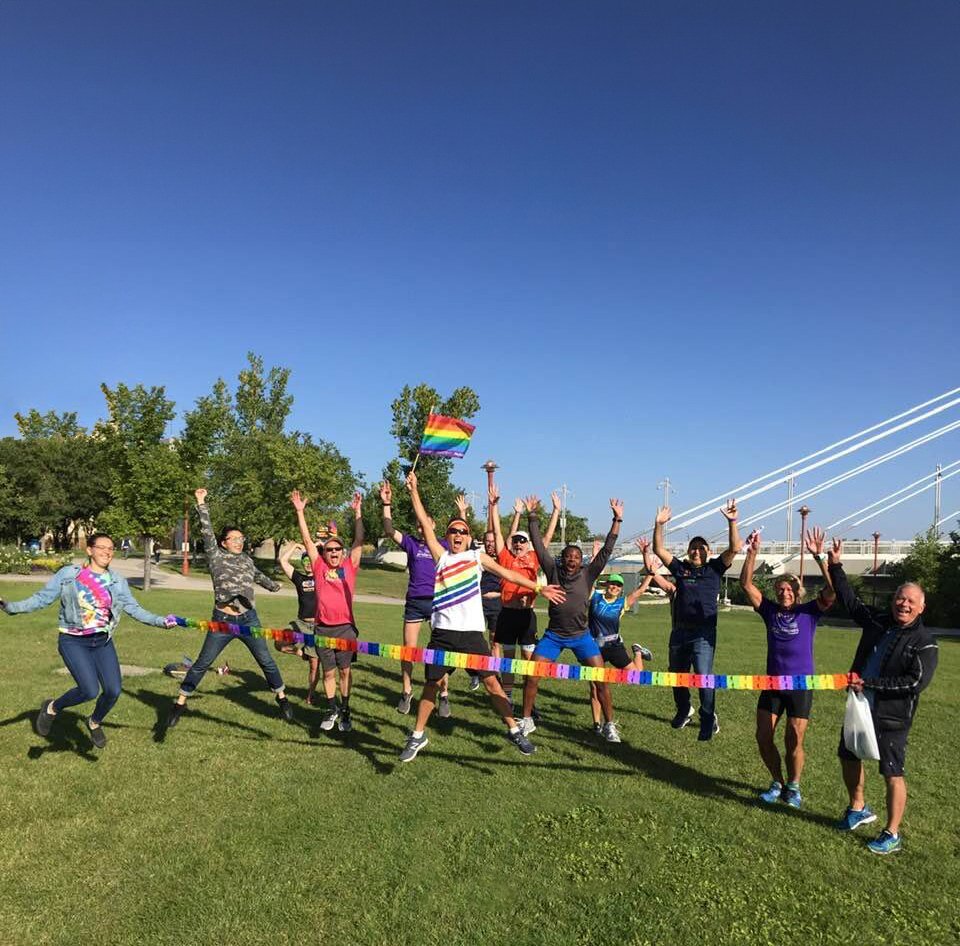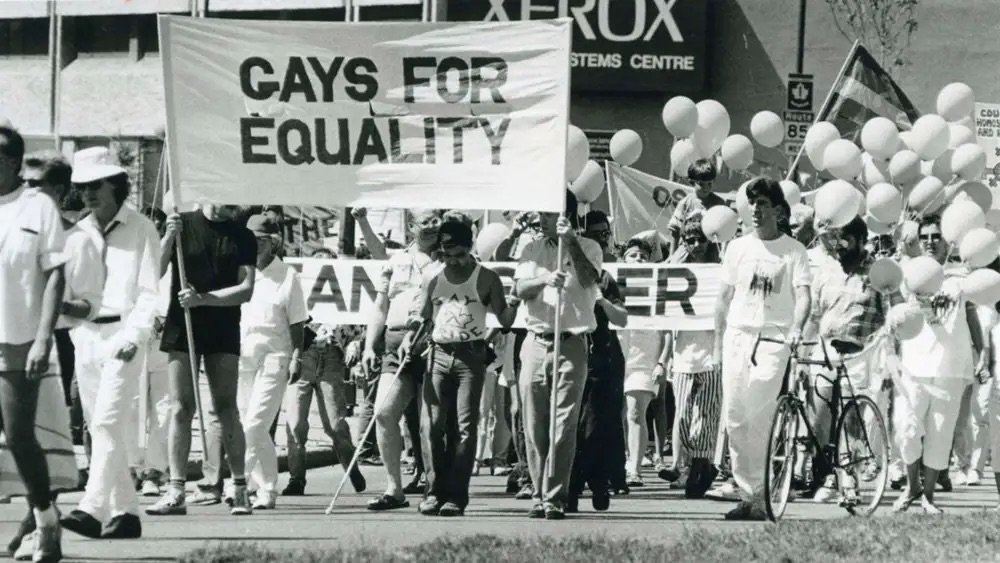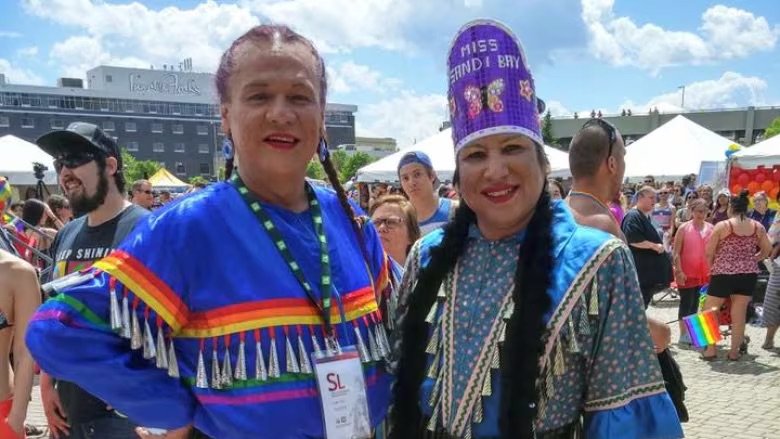
QUEER HISTORY: WINNIPEG VS. THE WORLD
As a 2SLGBTQ+ organization, Out There Winnipeg acknowledges the importance of sharing our community’s rich, perilous history throughout Winnipeg, and throughout the world.
PUBLIC DOMAIN IMAGE VIA THE UNIVERSITY OF LIVERPOOL
QUEER HISTORY - THE WORLD
In short…
Evidence of homosexuality and gender diversity dates back to ancient civilizations, with documented instances as early as 9,600 BCE. In cultures such as ancient Mesopotamia and Egypt, same-sex relationships were observed and celebrated without the need for modern labels like "LGBTQ+" or "queer".
The spread of European colonialism across Europe in 1290 led to a surge in the persecution of LGBTQ+ individuals throughout the world, marked by the imposition of sodomy laws. From there, traditional Christian doctrines were enforced, resulting in the marginalization—and frequently the lethal persecution—of individuals whose gender, ethnicities, sexualities, and relationship structures diverged from the rigid, prescribed societal norms.
In 1952, homosexuality was pathologized as a "mental disorder" in the DSM-II, further reflecting societal stigmatization. This oppression spurred the emergence of LGBTQ+ rights movements, notably seen in the Harlem Renaissance and the Stonewall Inn uprising of 1969.
In the late 20th century, the formation of LGBTQ+ advocacy groups marked a pivotal moment in the fight for legal recognition and societal acceptance throughout Turtle Island (now known as North America). Despite significant strides from then to now, including the decriminalization of homosexuality and the legalization of same-sex marriage in several countries, LGBTQ+ individuals continue to face pervasive discrimination in employment, housing, and public accommodations. Additionally, healthcare disparities persist, with LGBTQ+ individuals often encountering barriers to accessing culturally competent and affirming healthcare services.
Throughout history, the 2SLGBTQ+ community has exhibited resilience and solidarity in the face of adversity, advocating for justice, equality, and liberation. Despite a number of strides in legislation and societal acceptance throughout the most recent years, the fight for a safe, equitable society still continues to this day.
DEMONSTRATIONS OUTSIDE CITY HALL IN 1971, WHEN A BILL GUARANTEEING EQUAL JOB OPPORTUNITIES FOR GAY PEOPLE STALLED IN NEW YORK CITY COUNCIL. PHOTOGRAPH BY GREY VILLET/CONTRIBUTOR.
PHOTO BY @CARRIER_LOST VIA UNSPLASH
QUEER HISTORY - WINNIPEG
Winnipeg has long been a welcoming city, with a community that has seemingly always fought for for 2SLGBTQ+ rights. You’d have to look all the way back to the 1920s to find our first underground gay establishments – which you can, via the University of Manitoba’s Manitoba Gay/Lesbian Archive’s Oral History Project.
One of Winnipeg’s first notable gay bars was Club 654, a members only after-hours club where liquor was not sold. Club 654’s opening, on a Sunday afternoon in 1970, attracted more than 200 people. A year or so before this, on Halloween night in 1968, the first drag ball was held in Winnipeg at the Sildor Ballroom.
Unlike notorious “raids” at other gay clubs in cities across Canada, there were no raids at Winnipeg’s gay bars. This tolerance has been attributed to the work of people like, the Honourable Ruth Krindle, the now retired judge who was instrumental in advocating LGBTQ2 rights, including being counsel for Winnipeg’s first gay club in 1969.
Within this environment, by the early 70s, notable establishments like Happenings Social Club (1974-2002) and the Mardis Gras offered the community a place to call their own. The 70s also saw a good deal of equal rights marches which had been fostered by Winnipeg’s politically active university campuses. It was also during this time that the Manitoba Gay Coalition was established, which included organizations from the more rural communities of Thompson and Brandon.
Winnipeg’s community has always been well represented in its artistic endeavours. A noteworthy example was the 1980s public access television show Coming Out. This program, which featured openly gay people, was pretty much unheard of at the time. Also of note in the 80s was the opening of Giovanni’s Room in 1982. This legendary club, which would become Gio’s Club and Bar, stayed open for 31 years and was often considered the heart of Winnipeg’s LGBTQ2 scene.
Winnipeg’s first pride parade took place on Sunday, August 2, 1987 on the heels of Manitoba’s Human Rights Code – which protected the rights of gays and lesbians – being past. This first parade featured 250 participants, several of whom wore paper bags over their head for fear of being ostracized. The Pride Winnipeg Festival has taken place ever since, growing from a single day event to a 10-day celebration.
It was a huge moment in Winnipeg’s proud 2SLGBTQ+ history, one that may only have been eclipsed when Glen Murray – an openly gay man who had spoke to Manitoba’s legislature before the passing of The Human Rights Code – was elected mayor in 1998. He would later be re-elected in 2002.
The term Two-Spirit was also coined in Winnipeg by academic Albert William McLeod, who, in the words of the University of Winnipeg (where he holds an honorary Doctor of Laws), “has led the way for rights and recognition of 2S people in North America since 1986.” This includes working “with LGBTQ Indigenous people across the continent to organize under the name ‘Two Spirit’ to remember the honoured roles of non-binary gender people in pre-contact First Nations, and the important spiritual role they played within their communities.”
Two-Spirit is derived from the Anishinaabeg term niizh manidoowag – a reference to a person who embodies both a masculine and feminine spirit.
This brief 2SLGBTQ+ History of Winnipeg was written by Tourism Winnipeg.
STILL SHOT FROM CBC DOCUMENTARY “ONE GAY CITY: A HISTORY OF LGBT LIFE IN WINNIPEG” (CBC)
1974 WINNIPEG GAY PRIDE MARCH (MANITOBA GAY AND LESBIAN ARCHIVES/UNIVERSITY OF MANITOBA)
1984 GAY RIGHTS RALLY/PROTEST (PHIL HOSSACK/WINNIPEG FREE PRESS)
COMMUNITY CENTRE PAMPHLET (MANITOBA GAY AND LESBIAN ARCHIVES/ UNIVERSITY OF MANITOBA)
1974 GAY PRIDE MARCH (UNIVERSITY OF MANITOBA DIGITAL COLLECTIONS: GAY AND LESBIAN ARCHIVES)
1987 GAY PRIDE PARADE (WAYNE GLOWACKI/WINNIPEG FREE PRESS)
2017 WINNIPEG PRIDE TWO-SPIRIT POWWOW (RICHELLE BAKER)
REFERENCES
Tourism Winnipeg Writers & Editors. A (somewhat brief) 2SLGBTQ+ History of Winnipeg. Tourism Winnipeg.
https://www.tourismwinnipeg.com/things-to-do/lgbt
Mark, J. (2023, 25 June). LGBTQ+ in the Ancient World. World History Encyclopedia. https://www.worldhistory.org/article/1790/lgbtq-in-the-ancient-world
Morris, B. (2023, 16 March). A brief history of lesbian, gay, bisexual, and transgender social movements. American Psychological Association.
https://www.apa.org/topics/lgbtq/history
A History of LGBT Criminalization. Human Dignity Trust.
https://www.humandignitytrust.org/lgbt-the-law/a-history-of-criminalisation
Webster, R. Magdoff, H. Nowell, C. (2023, 18 December). Western colonialism. Encyclopedia Britannica.
https://www.britannica.com/topic/Western-colonialism/Spains-American-empire
Atkinson, T. (2021, 12 February). Sexuality in the Past: Niankhkhnum and Khnumhotep. University of Liverpool.
https://www.liverpool.ac.uk/archaeology-classics-and-egyptology/blog/2021/sexuality-in-the-past
History.com Writers & Editors. (2023, 23 June). Stonewall Riots. HISTORY.
https://www.history.com/topics/gay-rights/the-stonewall-riots












